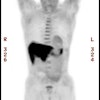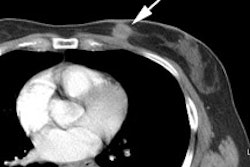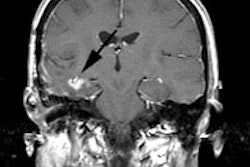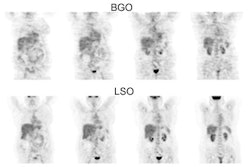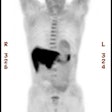J Clin Oncol 2000 Apr;18(8):1676-88
Positron emission tomography using [(18)F]-fluorodeoxy-D-glucose to
predict the pathologic response of breast cancer to primary chemotherapy.
Smith IC, Welch AE, Hutcheon AW, Miller ID, Payne S, Chilcott F, Waikar S, Whitaker T,
Ah-See AK, Eremin O, Heys SD, Gilbert FJ, Sharp PF.
PURPOSE: To determine whether [(18)F]-fluorodeoxy-D-glucose ([(18)F]-FDG) positron
emission tomography (PET) can predict the pathologic response of primary and metastatic
breast cancer to chemotherapy. PATIENTS AND METHODS: Thirty patients with noninflammatory,
large (> 3 cm), or locally advanced breast cancers received eight doses of primary
chemotherapy. Dynamic PET imaging was performed immediately before the first, second, and
fifth doses and after the last dose of treatment. Primary tumors and involved axillary
lymph nodes were identified, and the [(18)F]-FDG uptake values were calculated (expressed
as semiquantitative dose uptake ratio [DUR] and influx constant [K]). Pathologic response
was determined after chemotherapy by evaluation of surgical resection specimens. RESULTS:
Thirty-one primary breast lesions were identified. The mean pretreatment DUR values of the
eight lesions that achieved a complete microscopic pathologic response were significantly
(P =.037) higher than those from less responsive lesions. The mean reduction in DUR after
the first pulse of chemotherapy was significantly greater in lesions that achieved a
partial (P =.013), complete macroscopic (P =.003), or complete microscopic (P =.001)
pathologic response. PET after a single pulse of chemotherapy was able to predict complete
pathologic response with a sensitivity of 90% and a specificity of 74%. Eleven patients
had pathologic evidence of lymph node metastases. Mean pretreatment DUR values in the
metastatic lesions that responded did not differ significantly from those that failed to
respond (P =.076). However, mean pretreatment K values were significantly higher in
ultimately responsive cancers (P =.037). The mean change in DUR and K after the first
pulse of chemotherapy was significantly greater in responding lesions (DUR, P =.038; K, P
=.012). CONCLUSION: [(18)F]-FDG PET imaging of primary and metastatic breast cancer after
a single pulse of chemotherapy may be of value in the prediction of pathologic treatment
response.

